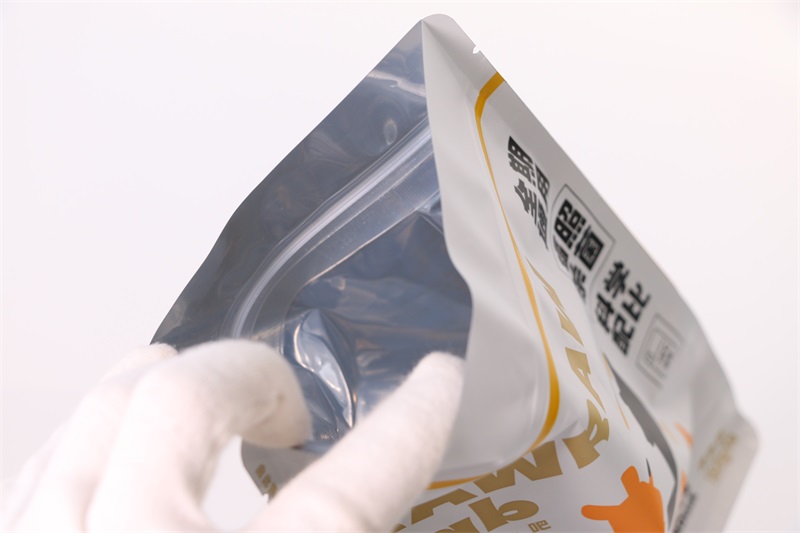1. Single layer film
It is required to be transparent, non-toxic, impermeable, with good heat-sealing bag-making, heat and cold resistance, mechanical strength, grease resistance, chemical resistance, and anti-blocking.
2. Aluminum foil bag
99.5% pure electrolytic aluminum is melted and pressed into foil by a calender, which is ideal as a substrate for flexible plastic packaging.
3. Vacuum evaporation aluminum film
Under high vacuum, low-boiling metals, such as aluminum, are melted and vaporized and deposited on the plastic film on the cooling drum to form an aluminized film with good metallic luster.
4. Silicon coating
A transparent packaging material with extremely high barrier properties developed in the 1980s, also known as ceramic coating.
5. Glue (dry/wet) composite film
Monolayer films have certain advantages and inherent disadvantages. Wet composite film method: one substrate is coated with glue and then laminated with another substrate film, and then dried and cured. If it is a non-porous material, the glue drying may be poor and the quality of the composite membrane will decrease. Dry lamination method: Coat the adhesive on the substrate, let the adhesive dry first, and then press and laminate to bond the films of different substrates.
6. Extrusion coating composite film
On an extruder, the thermoplastic is cast through a T-die on the paper, foil, plastic substrate to be coated, or the extruded resin is used as an intermediate binder, and another film substrate is hot. The materials are pressed together to form a “sandwich” composite film.
7. Coextrusion composite film
Using two or three extruders, sharing a composite die, laminates between several compatible thermoplastics to produce multilayer films or sheets.
8. High barrier film
Refers to a material with a thickness of 25.4μm under the conditions of 23°C and RH65%, the oxygen transmission rate is below 5ml/m2·d, and the moisture transmission rate is below 2g/m2·d.
9. Fresh-keeping and sterilization film
Ethylene gas adsorption membrane, adding zeolite, cristobalite, silica and other substances to the membrane can absorb the ethylene gas exhaled by fruits and vegetables and inhibit their ripening too fast.
Anti-condensation and fogging film, the inner surface of the packaging film of green fruit has more condensation and fogging, which is easy to cause mildew on the food.
Antibacterial film, adding synthetic zeolite (SiO2+Al2O3) with ion exchange function to plastic material, and then adding inorganic filler containing silver ions, silver sodium ion exchange becomes silver zeolite, and its surface has antibacterial properties.
The far-infrared fresh-keeping film is mixed with a ceramic filler in the plastic film, so that the film has the function of generating far-infrared rays, which can not only sterilize, but also activate the cells in the green fruit, so it has the function of preserving freshness.
10. Aseptic packaging film
Mainly used in the production of aseptic packaging of food and medicine, it is required to have: sterilization resistance; high barrier properties and strength; good heat and cold resistance (-20 ℃ not brittle); needle-punching resistance and good bending resistance; The printed pattern will not be damaged in high temperature sterilization or other sterilization methods.
11. High temperature resistant cooking bag
In the 1960s, the U.S. Naval Research Institute first developed and applied it to aerospace food. After that, Japan quickly promoted it and developed and applied it to various new types of convenience food. High-temperature cooking bags can be divided into transparent type (with a shelf life of more than one year) and non-transparent type (with a shelf life of more than two years), high-barrier type and ordinary type. According to the sterilization temperature, it is divided into low temperature cooking bag (100℃, 30min), medium temperature cooking bag (121℃, 30min), high temperature cooking bag (135℃, 30min). The inner layer material of the retort bag is made of various cast and inflated PE (LDPE, HDPE, MPE) films, high temperature resistant cast CPP or inflated IPP, etc.
The main advantages of high temperature cooking bags:
①High temperature cooking can kill all bacteria, 121℃/30min can kill all botulinum bacteria;
②It can be stored at room temperature for a long time without refrigeration, and can be eaten cold or warm;
③ The packaging material has good barrier properties, no less than canned food;
④Reverse printing, beautiful printing and decoration;
⑤ Wastes are easy to be incinerated.
12. High temperature packaging film
The melting point of the material is above 200°C, which is suitable for high-strength rigid/soft containers.
13. Degradable plastic film
Degradable plastic products can be divided into photodegradation, biodegradation, photodegradation and biodegradation according to the decomposition mechanism.
14. Heat shrinkable film
Materials are PP, PVC, LDPE, PER, nylon, etc. First extrude the film, at a temperature above the softening temperature (glass transition point) and below the melting temperature, in a highly elastic state, use the synchronous or two-step flat-die stretching method, or the calendering method, or the solvent The casting method performs directional stretching, and the stretching molecules are cooled below the glass transition point and locked.
Post time: Apr-25-2022


